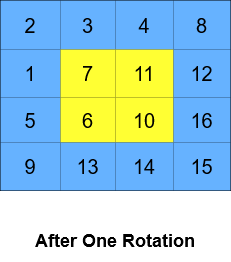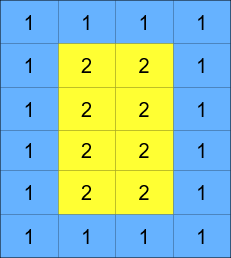You are given an m x n integer matrix grid, where m and n are both even integers, and an integer k.
The matrix is composed of several layers, which is shown in the below image, where each color is its own layer:
A cyclic rotation of the matrix is done by cyclically rotating each layer in the matrix. To cyclically rotate a layer once, each element in the layer will take the place of the adjacent element in the counter-clockwise direction. An example rotation is shown below:
Return the matrix after applying k cyclic rotations to it.
Example 1:
Input: grid = [[40,10],[30,20]], k = 1 Output: [[10,20],[40,30]] Explanation: The figures above represent the grid at every state.
Example 2:



Input: grid = [[1,2,3,4],[5,6,7,8],[9,10,11,12],[13,14,15,16]], k = 2 Output: [[3,4,8,12],[2,11,10,16],[1,7,6,15],[5,9,13,14]] Explanation: The figures above represent the grid at every state.
Constraints:
m == grid.lengthn == grid[i].length2 <= m, n <= 50- Both
mandnare even integers. 1 <= grid[i][j] <= 50001 <= k <= 109
Related Topics:
Array
The rotate function comes from 189. Rotate Array (Medium).
// OJ: https://leetcode.com/problems/cyclically-rotating-a-grid/
// Author: github.com/lzl124631x
// Time: O(MN)
// Space: O(M + N)
class Solution {
void rotate(vector<int>& A, int k) {
int cnt = 0, N = A.size();
k %= N;
if (k == 0) return;
for (int i = 0; cnt < N; ++i) {
int j = i, tmp = A[j];
do {
int t = (j + k) % N, next = A[t];
A[t] = tmp;
tmp = next;
j = t;
++cnt;
} while (j != i);
}
}
public:
vector<vector<int>> rotateGrid(vector<vector<int>>& A, int K) {
int M = A.size(), N = A[0].size();
for (int i = 0; i < min(M, N) / 2; ++i) {
int x = i, y = i, h = M - 2 * i, w = N - 2 * i, k = 0, len = 2 * (h + w - 2);
vector<int> v(len);
for (int j = 1; j < w; ++j, ++y) v[k++] = A[x][y];
for (int j = 1; j < h; ++j, ++x) v[k++] = A[x][y];
for (int j = 1; j < w; ++j, --y) v[k++] = A[x][y];
for (int j = 1; j < h; ++j, --x) v[k++] = A[x][y];
rotate(v, len - K % len);
x = i, y = i, k = 0;
for (int j = 1; j < w; ++j, ++y) A[x][y] = v[k++];
for (int j = 1; j < h; ++j, ++x) A[x][y] = v[k++];
for (int j = 1; j < w; ++j, --y) A[x][y] = v[k++];
for (int j = 1; j < h; ++j, --x) A[x][y] = v[k++] ;
}
return A;
}
};

